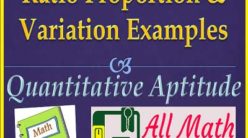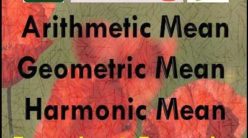List of Formulas for Average Tricks with Examples |Average aptitude shortcuts
Average is one of the most important mathematical concepts that we use in our day-to-day life. In fact, even the most non-mathematical individuals regularly utilize the concept of averages on a day-to-day basis. In this article provides average concepts and Average formulas with examples.
Average Concept:
The average of a number is a measure of the central tendency of a set of numbers. In other words, it is an estimate of where the center point of a set of numbers lies.
i.e Average equals to the ratio of Sum of observations to Number of observations.
The basic formula for average of “M” numbers is n1, n2, n3, n4 …….. nm is
This also means
Am x M = Total of the set of numbers.
The average is also known as arithmetic mean (AM). So average of set of numbers can also be defined as the number by which we can replace each and every number of the set without changing the total of the set of numbers.
For example, the average of 4 numbers 16, 18, 24 and 26 is ( 16 + 18 + 24 + 26)/4 = 84/ 4 = 21
This means that if each of the 4 numbers of the set were replaced by 15 each, there would be no changes in the total.
This can be visualized as
16 + 5 = 21
18 + 3 = 21
24 – 3 = 21
26 – 5 = 21
Note:
a) The average is always calculated for a set of numbers.
b) The average always lies above the lowest number of the set and below the highest number of the set.
c) The net deficit due to the numbers below the average always equals the net surplus due to the members above the average.
d) The average of some numbers is “A” , Now all numbers are multiplied by “N” then its new average equal to (A x N)
e) The average of some numbers is “A” , Now all numbers are divided by “N” then its new average equal to A / N
f) If average of some numbers is “A” and “N” is added in each numbers, then new average is (A + N).
g) If average of some numbers is ” A” and “N” is subtracted in each number, then new average is (A -N ).
Average formula – 1 (Weighted Average)
When we have two or more groups whose individual averages are known, then to find the combined average of all elements of all the groups we use weighted average.
If we have “ n” groups with averages A1,A2, A3, A4 ……. An and having X1, X2, X3, X4, ……. Xn elements then the weighted average is given by the formula.
Example-1 : A school has only 3 classes that contain 20, 30 and 10 students respectively. The pass percentage of these classes are 80%, 70% & 60% respectively then find the pass percentage of the entire school?
Solution: From the above formula
The pass percentage of the entire school
= 4300/60 = 71.67%
Average formula – 2 ( Average age /weight)
The “N ” persons average (Age/weight) is “A”, If a person is included in this group, then its new average is “ M” included persons age/weight ” P”
The Age of included person = No. of persons in group × (Increase in average) + New average
i. e P = N x ( M – A) + M
The “N ” persons average (Age/weight) is “A”, If a person is excluded in this group, then its new average is “ M” excluded persons age/weight “ P”
The Age of excluded person = No. of persons in group × (Decreased in average) + New average
i. e P = N x ( A -M) + M
Example – 2 : The average age of 30 students is 10 years. If the teacher’s age is included, the average age becomes 11 years. What is the teacher’s age?
Solution: By straight method to solve this sum
Total age of 30 students = 30 × 10 = 300 years.
Average age of 30 students and one teacher = 11 years
Total of their ages ( including the teacher)= 31 × 11 = 341 years
Teacher’s age = 341 – 300 = 41 years
Now by using formula
Teacher’s age = 30 ( 11 -10) + 11 = 30 + 11 = 41 years
Example – 3: The average weight of 25 students is 30 kgs. If one student excluded, the average remaining students weight becomes 29 kgs. What is the weight of excluded student?
Solution: By straight method to solve this sum
Total weight of 25 students = 25 x 30 = 750 kgs
Average weight of students with out one student = 29 kgs
Total of their weihjt ( excluding the student)= 24 x 29 = 696 kgs
Weight of the excluded student = 750 – 696 = 54 kgs
Now by using formula
Weight of the excluded student = 25 ( 30 – 29) + 29 = 25 + 29 = 54 years.
Average formula – 3🙁 Average age /weight)
When two or more than two persons included in a the group, then average weight of included person is
In the same way we can calculate in case of members excluded the group.
Example – 4: Average age of 20 students is 15 years. After including four new students their average age becomes 16 years, then find the average age of four new students.
Solution: According to above formula
Average age of four new students = [ (20 x 1 ) + (16 x 4 ) ] / 4
= [ 20 + 64] /4 = 84 / 4 = 21 years.
Average formula – 4: ( Average Speed )
Same distance at two different speeds –
If a person travels two equal distances at a speed of “a” km/hr and “b” km/hr, then average speed ” A ” km/hr
Same distance at three different speeds –
If a person travels three equal distances at a speed of “a” km/hr, “b” km/hr & “c” km/hr, then average speed ” A “ km/hr
Example – 5 : A student travels to reach a school at a speed of 10 km/hr and returns at the rate of 12 km/hr. What is the average speed of the student?
Solution: According to above formula
Average speed of the student = 2 x 10 x 12 / ( 10+12)
= 240 / 22 = 10.91 km/hr.
Example – 6 : If a person travels three equal distances at a speed of “15” km/hr, “20” km/hr & “10” km/hr, then find average speed of that person.
Solution: According to above formula
Average speed of the person
= (180/13) km/hr
Example – 7: With an average speed of 50 km/hr, a train reaches its destination in time. If it goes with an average speed of 45 km/hr, it is late by 10 minutes. What is the total distance?
Solution: Let take ” x “ km be the total distance
Total time taken to reach the destination in right time = ( x / 50 ) hours
Time taken while travel at 45 km/hr speed = (x / 45) hours
The difference between both traveling time = 10 minutes = (10/ 60) hours
i.e
Now simplifying the above equation, we will get x = 75
Total distance = 75 km.
Example – 8: A person covers half his journey by train at 60 kmph, the remainder half by bus at 30 kmph and the rest by motor vehicle at 20 kmph. Find his average speed during the entire journey.
Solution: Here journey by bus and that by motor vehicle are equal distance.
Now we can find the average speed of half of the journey by using formula
= 2 x 30 x 20 / (30+ 20)
= 1200 / 50 = 24 kmph.
Now half his journey by train at 60 kmph and remaining journey average speed is 24 kmph
The average speed of total journey = 2 x 60 x 24 / (60+24) = (240/7) kmph.
———————————————- X ————————————————
Hi friends Thanks for reading. I Hope you liked it. Give feed back, comments and please don’t forget to share it
Average Formulas with Examples | Exercise- II
Average Problems | Exercise – III
Topics in Quantitative aptitude math for all types of exams
Shortcut Math Tricks for helpful to improve speed in all calculations






